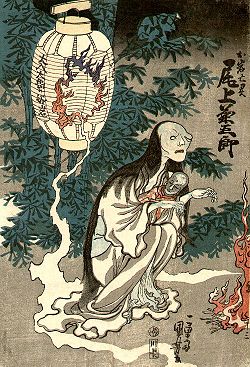The book opens with a general introduction to yurei, or ghosts of Japan, as opposed to yokai, or monsters. There's an extensive literary, folkloric, and artistic heritage of the uncanny in Japan, and it's really clear that it's the book's purpose to open that up to western viewers whose familiarity may not run much past Ringu and Ju-On and other J-horror films.
There are themed sections to the book. In "Sexy & Scary" there's a series of seductive female phantoms, including some from The Tale of Genji and my beloved Ugetsu Monogatari. These ladies range from the pathetic, like Okiku, the plate-counting phantom, to the infamous Oiwa, the template for Japanese female ghosts.
 | |
| Oiwa emerging from a lantern. |
Up next is "Furious Phantoms," with specters motivated by rage and revenge. Included in this section are Taira No Masakado, a historical figure whose shrine occupies valuable Tokyo real estate but is still honored and feared today. Another is a fictionalized ghost story based on real-life kabuki actor Kohada Koheiji, who died in the 1700s.
 |
| Koheiji, in a famous print by Hokusai. |
 |
| The Okiku Doll, another haunted possession in Japanese lore. |
"Haunted Places" is a fun chapter because so many of the stories are from historical sources, some not all that long ago. Tabaruzaka, a hill near Kumamoto, has a haunting from a real battle of the Satsuma Rebellion in 1877. Mount Hakkoda is haunted by soldiers who died there during a disastrous training exercise in 1902; they were trapped, unprepared, during a "normal" cold-weather survival mission, that went hideously awry when a history-making blizzard hit the area, with record low temperatures, and out of 210 soldiers, only 11 survived, some as multiple amputees. There's also Japan's famous Suicide Forest (where a staggeringly high number of people go to off themselves), Jomon Tunnel (haunted by those who died during the construction in 1914), and Oiran Buchi (a waterfall where 55 courtesans committed suicide in the 1570s).
 |
| The Hakkoda mountains, now a ski resort. |
Chapter Six, "Close Encounters," has three tales of famous meetings with ghosts, including the famous "Hoichi the Earless" which was recounted in Lafcadio Hearn's Kwaidan and dramatized in the famous film of the same name. There's a tale each about Yuten Shonin, a famous real-life exorcist, and Ono No Takamura, a poet and scholar who is supposed to have visited Hell. The appendices include a selection of ghost-related toys and merchandise, and suggestions for further reading.
Yurei Attack! is fun, spooky reading; Yoda and Alt do a very good job of making this part of Japanese pop culture accessible to Westerners. It's got a ton of illustrations, with a lot of classic Japanese ghost art from great artists, and modern manga drawings from Shinkichi.
This is great stuff, folks. Look it up, find it, and read it. It's available as a physical book and I think also for the Kindle.






2 comments:
Thanks for the kind words! Glad you enjoyed it... as a fellow former Takoma Park-er! ;)
-Matt
You're most welcome; it was a joy to read. And I'm thrilled at the serendipity of our local connection, although soon I'll be a former Takoma Parker myself...
Post a Comment